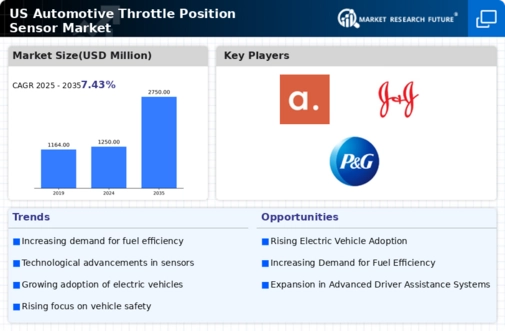Focus on Emission Regulations
Stringent emission regulations in the United States are significantly influencing the US Automotive Throttle Position Sensor Market. Regulatory bodies such as the Environmental Protection Agency (EPA) have established strict guidelines to reduce vehicle emissions, compelling manufacturers to adopt advanced technologies. Throttle position sensors play a vital role in ensuring that engines operate within these regulatory frameworks by optimizing air-fuel mixtures and improving combustion efficiency. As compliance with these regulations becomes increasingly critical, the demand for high-quality throttle position sensors is expected to rise. This regulatory environment not only drives innovation within the US Automotive Throttle Position Sensor Market but also encourages manufacturers to invest in research and development to meet evolving standards.
Increased Demand for Electric Vehicles
The shift towards electric vehicles (EVs) is a pivotal driver for the US Automotive Throttle Position Sensor Market. As more consumers opt for EVs, the need for advanced throttle position sensors that can efficiently manage electric drivetrains becomes paramount. The US government has been promoting EV adoption through various incentives and policies, which further stimulates market growth. Data indicates that the EV market share in the US is expected to reach 30% by 2030, necessitating the integration of sophisticated throttle position sensors to optimize performance. This trend not only supports the growth of the US Automotive Throttle Position Sensor Market but also aligns with broader environmental goals, making it a critical area of focus for manufacturers.
Technological Advancements in Sensor Design
The US Automotive Throttle Position Sensor Market is experiencing a surge in technological advancements that enhance sensor design and functionality. Innovations such as digital signal processing and improved materials are leading to more accurate and reliable throttle position sensors. These advancements are crucial as they contribute to better engine performance and fuel efficiency, which are increasingly demanded by consumers. According to recent data, the market for automotive sensors in the US is projected to grow significantly, driven by the need for enhanced vehicle performance and safety features. As manufacturers adopt these new technologies, the US Automotive Throttle Position Sensor Market is likely to see a corresponding increase in demand, reflecting a broader trend towards smarter automotive systems.
Rising Consumer Awareness of Vehicle Performance
Increasing consumer awareness regarding vehicle performance and efficiency is driving demand within the US Automotive Throttle Position Sensor Market. As consumers become more informed about the impact of throttle position sensors on fuel economy and overall vehicle performance, they are more likely to prioritize vehicles equipped with advanced sensor technologies. This trend is reflected in market data, which indicates a growing preference for vehicles that offer enhanced performance features. Manufacturers are responding to this demand by integrating high-quality throttle position sensors into their vehicles, thereby improving performance metrics. Consequently, the US Automotive Throttle Position Sensor Market is poised for growth as it aligns with consumer expectations for better fuel efficiency and performance.
Growth of Advanced Driver Assistance Systems (ADAS)
The proliferation of Advanced Driver Assistance Systems (ADAS) is emerging as a significant driver for the US Automotive Throttle Position Sensor Market. As vehicles become more automated, the integration of throttle position sensors with ADAS technologies is essential for enhancing vehicle control and safety. These systems rely on precise data from throttle position sensors to make real-time adjustments, ensuring optimal performance. The US market for ADAS is projected to grow substantially, with estimates suggesting a compound annual growth rate (CAGR) of over 20% in the coming years. This growth is likely to propel the demand for throttle position sensors, as manufacturers seek to incorporate these components into their ADAS offerings, thereby reinforcing the importance of the US Automotive Throttle Position Sensor Market.













